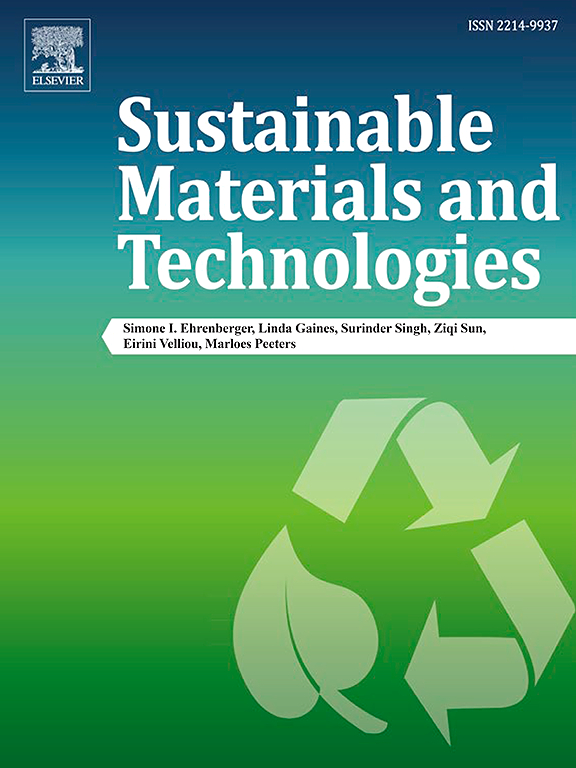Facile fabrication of high-performance electrochromic fabrics based on flexible Ag/Ni mesh electrode with exceptional conductivity
IF 8.6
2区 工程技术
Q1 ENERGY & FUELS
引用次数: 0
Abstract
Flexible electrochromic devices (FECDs) and electrochromic fabrics (ECFs) have attracted great attention in fashion clothing decoration and camouflage due to their low energy consumption and bi-stability. However, the complex and hierarchical structures of fabric substrates pose formidable challenges to the excellent and stable conductivity of ECFs. Here, we developed novel ECFs with excellent EC properties and outstanding stability by integrating FECDs with polyester fabric. Firstly, highly conductive silver (Ag)/nickel (Ni) mesh was heat-laminated on the thermoplastic polyurethane (TPU) film, serving as flexible electrode with high transmittance. On this basis, the FECDs exhibit an exceptionally high transmittance (46.4 %), rapid response time (bleaching for 0.5 s at 0.8 V and coloring for 0.9 s at −0.4 V), outstanding stability (2.6 % decreased after 5000 cyclic switching), and low-power consumption (<0.05 J per cycle in 60 cm2 FECDs). By harnessing the thermoplastic property of TPU, the FECDs can be readily transferred to fabric for the realization of ECFs, without compromising their comprehensive performances. More importantly, the outstanding conductivity and mechanical stability of ECFs under various challenging conditions (mechanical bending, physical damage, etc.) are unparalleled. We believe the simple-structured high-performance ECFs would be promising for flexible smart textile in any textile-based markets, such as wearable and intelligence camouflage.
基于具有优异导电性的柔性银/镍网状电极的高性能电致变色织物的简易制备
柔性电致变色器件(FECD)和电致变色织物(ECF)因其低能耗和双稳定性,在时尚服装装饰和伪装领域引起了极大关注。然而,织物基底复杂的分层结构给电致发光织物的卓越和稳定导电性带来了巨大挑战。在此,我们通过将 FECD 与聚酯织物结合,开发出了具有优异导电性能和出色稳定性的新型 ECF。首先,高导电性银(Ag)/镍(Ni)网被热贴在热塑性聚氨酯(TPU)薄膜上,作为具有高透光率的柔性电极。在此基础上,柔性蚀刻电路具有极高的透光率(46.4%)、快速的响应时间(0.8 V 时漂白 0.5 秒,-0.4 V 时着色 0.9 秒)、出色的稳定性(5000 次循环切换后降低 2.6%)和低功耗(60 cm2 柔性蚀刻电路每个循环 0.05 焦耳)。通过利用热塑性聚氨酯的热塑性特性,FECD 可以很容易地转移到织物上,从而实现 ECF,而不会影响其综合性能。更重要的是,ECFs 在各种挑战性条件(机械弯曲、物理损坏等)下具有无与伦比的出色导电性和机械稳定性。我们相信,这种结构简单的高性能 ECFs 将有望用于任何基于纺织品的柔性智能纺织品市场,例如可穿戴和智能伪装。
本文章由计算机程序翻译,如有差异,请以英文原文为准。
求助全文
约1分钟内获得全文
求助全文
来源期刊

Sustainable Materials and Technologies
Energy-Renewable Energy, Sustainability and the Environment
CiteScore
13.40
自引率
4.20%
发文量
158
审稿时长
45 days
期刊介绍:
Sustainable Materials and Technologies (SM&T), an international, cross-disciplinary, fully open access journal published by Elsevier, focuses on original full-length research articles and reviews. It covers applied or fundamental science of nano-, micro-, meso-, and macro-scale aspects of materials and technologies for sustainable development. SM&T gives special attention to contributions that bridge the knowledge gap between materials and system designs.
 求助内容:
求助内容: 应助结果提醒方式:
应助结果提醒方式:


